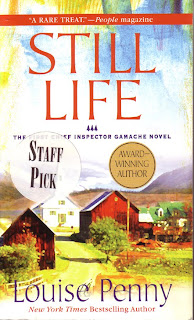A daily journal of our lives (begun in October 2010), in photos (many taken by my wife, Evie) and words, mostly from our home on Chautauqua Lake, in Western New York, where my wife Evie and I live, after my having retired from teaching English for forty-five years in Hawaii, Turkey, and Ohio. We have three children, seven grandchildren, and two great-grandsons, as you will notice if you follow my blog, since we often travel to visit them. : Morning Paddle, 12/06/25 at 8:47 AM
Sunday, November 4, 2012
STILL LIFE: LOUISE PENNY
A recommended mystery, from I am not sure where, set just outside of Montreal in modern times. The joy of this novel is the setting, a small, isolated Canadian town, with a panoply of interesting people.
The story takes place in small, quaint town of Three Pines. Miss Jane Neal, retired school teacher and friend to all, is found dead on the path leading from her house, obviously killed by an arrow through her body. At first, the authorities are not sure if it was an accident or not, as lots of the locals are bow hunters, in fact just about all of them, so the first feint is towards hunters who may have inadvertently shot Jane. But soon Chief Inspector Armand Gamache of the Surete of Quebec, with help from the coroner, realizes it could not have been an accidental death. Thus begins the plot, the feints left and right until we discover who did the shooting.
The joy of the book is the small town, a convivial group, the last place something like this might have happened. We are at first taken outside the town, to a farmer's son, who was seen, along with a couple of other youths, throwing manure at the local bistro run by two gay men from the city. The town is appalled by this mischief and Jane is the first to see the boys and encounters them, telling them to stop which they do. For awhile we, and the boy's parents, think that he did it since he was out hunting that morning. We later find that he discovered the body, event touched it, but has nothing to do with it. And as a side note, he's not only an angry youth, at odds with his family, but a closet gay youth, getting back at the thing he hates the most when he flings the mature, his homosexual self.
Jane, herself, is an enigma, friendly to all, but she has never invited anyone into her house beyond the kitchen, which seemed odd to all. Even her best friends, Clara and Peter Morrow, both artists, have never been inside her home. We soon learn that Jane is a closet artist, never sharing her work with her friends, until the day before her murder, when a painting of the Fair, which includes everyone in the village, is put up for the local art show. This painting is the key to the murderer and we have to wait to the very end, after thinking perhaps Clara or her husband, or the resident bookstore owner, a black women from Montreal, or the local misanthrope and poet, who seem to dislike everything and everyone. We get to meet them all, at the Bistro, where Gamache stays and takes his meals. Most of the villagers stop by to talk, to help Gamache gather information, and whatever they give him, helps to implicate someone else. Thus, we move up and down the residents, wondering who done it.
We finally discover it's a neighbor, Ben Hadley, Peter Morrow's best friend, a bachelor, who not only has killed Jane but also his mother, a seeming shrew who had made his life miserable. Ben, a friend to all, seems to be the last person anyone suspected of the murder but as Gamache knows, there's always a reason though it may not seem obvious. In this case, Ben realized that Jane's picture of the Fair made it clear that he was probably responsible for his mother's death, a bit of a stretch but hey, it's fiction.
I liked the book mostly because of Inspector Gamache, his humanity and interest in psychology, and the various, well drawn people in the village. You like them until you didn't, then liked them again as we understood them more deeply.
Subscribe to:
Post Comments (Atom)

No comments:
Post a Comment